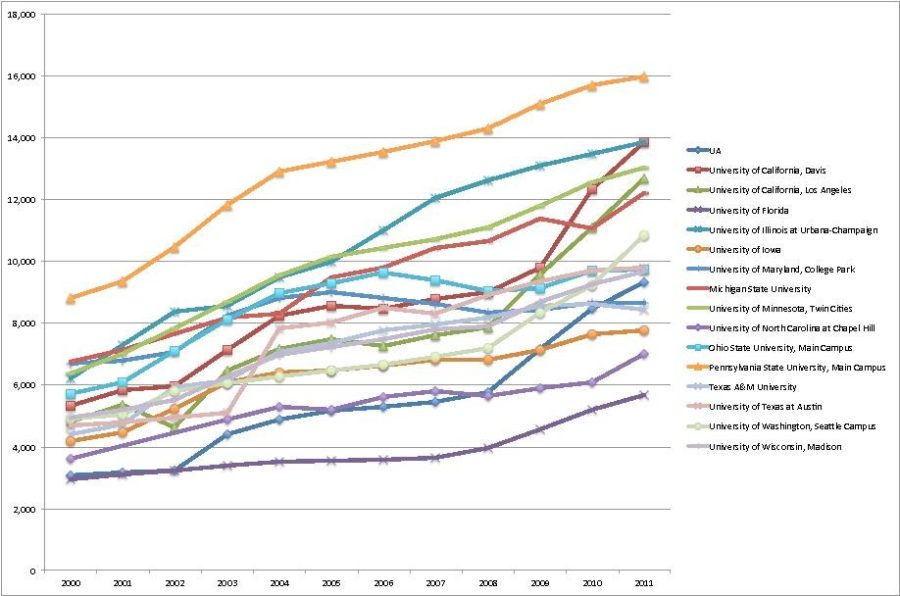Q: How do the UA’s recent tuition increases stack up against its peer universities?
A: When the Arizona Board of Regents approved the UA’s tuition proposal during its meeting on Thursday, it marked the first time since 1991 that the resident undergraduate tuition rate did not increase. It also marked the end of a four-year period where tuition nearly doubled, and exceeded $10,000 a year for the first time. But how do the UA’s tuition and fees stack up nationally?
Let’s compare the UA’s tuition and fees to that of its ABOR-determined peers. From 2000 to 2011, the UA and its peer institutions saw an average increase in tuition and fees of 106.6 percent, according to The Chronicle of Higher Education. The UA saw by far the highest rate of increase, at 204 percent. The lowest institutional increase can be found at the University of Maryland, which saw “only” a 29.4 percent increase in resident undergraduate tuition and fees over the last decade.
Looking at the decade holistically only tells part of the story, though. From 2000 to 2008, the UA’s tuition and fees jumped $2,703, an 88.4 percent increase. From 2008 to 2011, however, tuition and fees went up by another 61.4 percent, a $3,538 bump in three years.
Part of the UA’s large increase, which was roughly 40 percent steeper than any of its peers, can be attributed to its comparatively low costs in 2000. That year, tuition and fees for a UA resident undergraduate were $3,058, the second-lowest among its peer group and only higher than the University of Florida’s $2,938. By 2011, though, tuition and fees for a UA resident undergraduate were $9,299, the sixth-lowest among its peer group.
Another aspect of rising tuition is that the Council of Presidents, which is made up of the presidents of the three Arizona universities and the president of the regents, recommended in September 2010 that tuition be brought up to the median of each university’s peer institutions.
Those looking for relief in the future may be able to take comfort in Board of Regents’ policy. The regents used to stipulate that tuition could not rise above the top of the bottom one-third of its peer institutions. According to Katie Paquet, the associate vice president for public affairs and external relations for the board, that policy was revised last year to set the limit at the median tuition of the UA’s peers.
This year, the median tuition level is $9,816, compared to the UA’s resident undergraduate tuition of $10,035.
Paquet also said the board is focusing on building alternative pathways to degree attainment, using community colleges and satellite campuses, and still needs to see how things turn out with the state budget and federal health care law before next year’s tuition picture comes into focus.
“In terms of the future, things are a big unknown,” Paquet said.
— Luke Money









